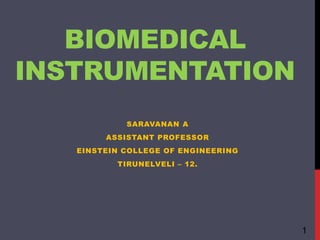
Basic Introduction Biomedical.pptx
- 1. BIOMEDICAL INSTRUMENTATION SARAVANAN A ASSISTANT PROFESSOR EINSTEIN COLLEGE OF ENGINEERING TIRUNELVELI – 12. 1
- 2. Instrumentation is the use of measuring instruments to monitor and control a process. It is the art and science of measurement and 2 process variables within a laboratory, or manufacturing control of production, area. INSTRUMENTATION
- 3. Biomedical Instrumentation is the field of creating such instruments that help us to measure, record and transmit data to or from the body. 3 BIOMEDICAL INSTRUMENTATION
- 4. • Direct / Indirect • Invasive / Noninvasive • Contact / Remote • Sense / Actuate • Real-time / Static 4 TYPES OF BIOMEDICAL INSTRUMENTATION SYSTEM
- 5. There are many instruments used in biomedical such as: X-Rays Electrocardiography (ECG) MRI Ultrasound CT Scan 5 INSTRUMENTS USED
- 6. X-RAYS 6 The frequency of x-rays as approximately 1020 Hz and its wave length is approximately 0.01 to 10 nanometer. It consist of high vacuum tube with a heater, cathode and anode, vacuum tube, a large DC voltage is used between cathode and anode of x-rays tube.
- 7. HOW IT PRODUCED 7 When heater is on and very high anode to cathode voltage is applied the electron emits from cathode and travel toward the anode with very high Velocity. This beam of electron strike the metal anode such speed that new rays are made from the slanting surface of the anode. These rays are x-rays, seem to the bounce sideways out thought well of the tube.
- 9. ELECTROCARDIOGRAPHY 9 the polarization and depolarization of cardiac tissue and translates into a Electrocardiography is the recording of the electrical activity of the heart. It picks up electrical impulses generated by waveform.
- 10. It detects and amplifies the tiny electrical changes on the skin that are caused when the heart muscle depolarizes during each heartbeat. 10 heart muscle cell has a At rest, each negative charge, called the membrane potential, across its cell membrane. CONT…
- 11. ECG SCREEN 11
- 13. Magnetic resonance imaging (MRI) makes use of the magnetic properties of certain atomic nuclei. 13 The hydrogen nuclei behave like compass needles that are partially aligned by a strong magnetic field in the scanner. MRI does not involve radioactivity or ionising radiation. The frequencies used (typically 40-130 MHz) are in the normal radiofrequency range, and there are no adverse health effects.
- 14. Advantages: 14 MRI is particularly useful for the scanning and detection of abnormalities in soft tissue structures in the body There is no involvement of any kind of radiations in the MRI. MRI scan can provide information about the blood circulation throughout the body and blood vessels.
- 15. Disadvantages: 15 MRI scan is done in an enclosed space, i.e. fearful of being in a closely enclosed surface, are facing problems with MRI to be done. MRI scans involve really loud noises while processing because they involve a really high amount of electric current supply. MRI scanners are usually expensive.
- 16. ULTRASOUND 16 Ultrasound is an oscillating sound pressure wave with a frequency greater than the upper limit of the human hearing range. The frequencies of ultrasound required for medical imaging are in the range 1 - 20 MHz. Ultrasound can be used for medical imaging, detection, measurement and cleaning.
- 17. 17
- 18. ADVANTAGE 18 Usually non-invasive, safe and relatively painless Uses no ionising radiation Does not usually require injection of a contrast medium (dye) DISADVANTAGES Quality and interpretation of the image highly depends on the skill of the person doing the scan. Use of a special probe is required in some ultrasounds Special preparations may be required before a procedure (e.g. fasting or a full bladder)
- 19. COMPUTERIZED TOMOGRAPHY 19 A 'computerized tomography' (CT) uses a computer that takes data from several X- ray images of structures inside a human's or animal's body and converts them into pictures on a monitor.
- 20. WORKING 20 A CT scanner emits a series of narrow beams through the human body as it moves through an arc. Inside the CT scanner there is an X-ray detector which can see hundreds of different levels of density. It can see tissues inside a solid organ. This data is transmitted to a computer, which builds up a 3D cross-sectional picture of the part of the body and displays it on the screen.
- 21. ADVANTAGES Quick and painless Can help diagnose and guide treatment for a wider range of conditions than plain X-rays Can detect or exclude the presence of more serious problems DISADVANTAGES Small increased risk of cancer in future from exposure to ionising radiation. Uses higher doses of radiation, so the risks (while still small) are in general greater than other imaging types 21
- 22. 22